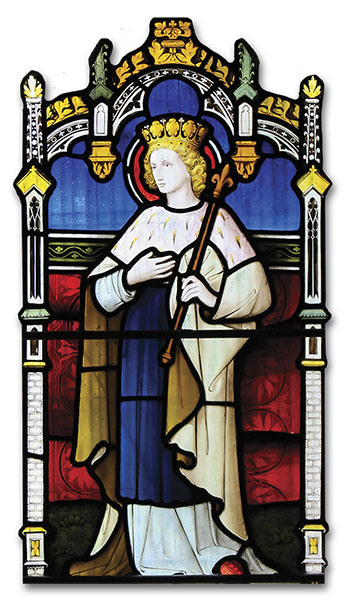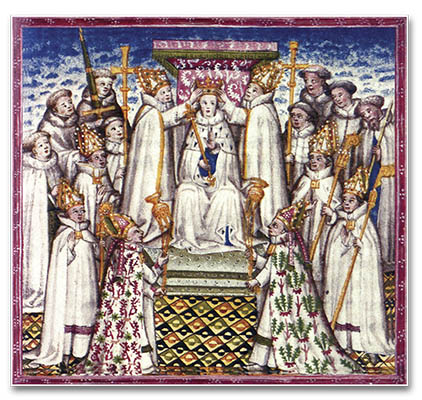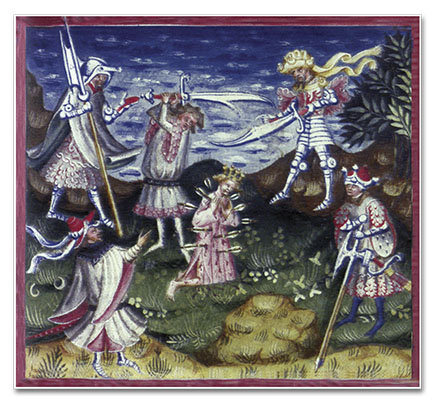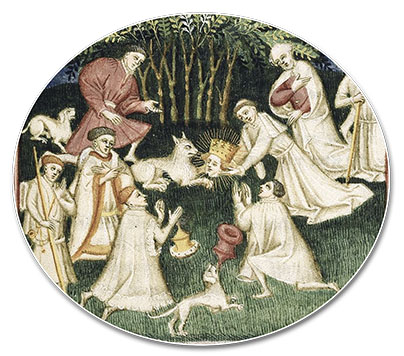Inflexible against the wicked and a true father to his subjects, this valiant king of unblemished purity knew how to be shrewd in fleeing from his enemies, but above all, to be a hero in answer to God’s call.
On England’s east coast, against the blue backdrop of the sea, towered a castle, King Edmund’s refuge in his moments of meditation and seclusion. This palace and its surroundings – later called Maidenboure, that is, the home of the virgin king in the old Saxon language – were an image of the purity of body and soul of this monarch who would mark history with his sagacity in the face of danger, sacrifice and struggle, and above all for his heroism when God called him to give his life for the salvation of his people.
Known and loved for his gentleness and compassion towards all, especially the neediest, this sovereign showed how it is in kindness to one’s neighbor and in purity of customs that one acquires the strength of spirit to face the worst situations boldly and courageously.
Some devout legends have been added to his legacy, and it is difficult to distinguish them from the strictly historical facts. True or not, they take nothing away from the glory of the Saint; on the contrary, they invite us to admire those who did not make sparing use of marvelous hues when it came to praising sanctity.
A child who shone like the sun

Edmund was born in the early Middle Ages, in the year 841. It seems that his family belonged to the nobility of the Kingdom of Saxony, in present-day Germany.
Tradition has it that his father prayed to God for a large and holy family and that, in order to obtain this favor, he was inspired by an Angel to visit the tomb of the Apostles in Rome. Accordingly, he set out on a pilgrimage. Along the way, he took lodging in the house of a noble widow. One day, while they were conversing, the lady had a vision: on the pilgrim’s breast she saw a bright sun scattering its rays everywhere, and she prophesied that a child would be born from him, whose fame would spread to the four corners of the earth, inspiring all men with the love of God.
Edmund was brought up in the Catholic Faith from his cradle; he learned to read and write – something uncommon in those days – in the Palatine schools founded by Charlemagne, who was almost a contemporary. He also learned Latin and devoted his study time to memorizing the Psalms.
Besides this, little is known of his childhood. A fair-haired boy with blue eyes, he was no different from other children of his age. However, when he was about twelve years old, his life would suddenly take another direction.
Chosen for royalty
The story goes that in the lands of East Anglia, the region of eastern England that today comprises the counties of Norfolk and Suffolk and part of Essex and Cambridgeshire, King Offa – who some claim to be Edmund’s uncle, and others say his cousin – lamented that he had no heir to succeed him on the throne, for his only son had renounced royalty to become a hermit. Foreseeing the imminent invasions of the Nordic tribes and fearing, above all, for the spiritual good of his people, he sought a courageous soul to whom he could entrust the crown.
To obtain this grace, he decided to set off on pilgrimage to the Holy Land. God had already prepared an answer to his supplications: at the midpoint of his journey, he stopped in the Kingdom of Saxony, where he stayed with Edmund’s family. Having discerned in the young man his worthy successor, Offa wished to adopt him as his son. Before continuing his journey, he removed the royal ring from his finger and, showing it to the boy, said: “Note well the design and seal of this ring. If, when I am far away, I indicate to you a wish of mine by means of this symbol, execute it without delay.”
The king continued his journey, visiting all the holy places where the God-Man had trod. At the end of the pilgrimage he went on to Constantinople to venerate the Holy Cross, where he felt his strength failing and death approaching. Gathering his subjects around him, he announced that the young Edmund was to succeed him on the throne and, giving them his ring, he surrendered his soul to God.
Offa’s subjects, resuming their journey, made their way to Edmund’s family, and insisted that the boy accompany them to East Anglia. His father, however, was reluctant to let him go. He was still too young to take over the government of a kingdom, he thought. But, fearful of opposing God’s plan for his son, he finally relented.
On the throne of East Anglia
It is said that when Edmund landed on the shores of his new homeland, he prostrated himself on the ground to say a prayer; as he rose, fountains of crystal-clear water sprang up from the arid soil, which became the means of working miraculous cures.
At Christmas 855, when Edmund was only fourteen years old, the nobles of Norfolk, headed by Bishop Humbert, formally recognized his sovereignty. However, despite the late monarch’s manifest wish, this was not enough for him to begin his reign. According to the customs of the country, the new king had to prove himself worthy of the dignity; only then would the people acknowledge him. Moreover, the kingdom was in turmoil due to the invasions of the Nordic barbarians and the greed of neighboring sovereigns, who aimed to conquer it.
The holy Bishop Humbert, whose word carried great weight in the nation, was willing to promote Edmund’s cause. A whole year went by, which the king spent almost entirely in seclusion awaiting the moment when he could effectively take charge of the government.

Finally, at Christmas of 856, Edmund was solemnly crowned sovereign of East Anglia. The procession that preceded the king’s entry was made up of clerics, monks and nobles, carrying their drawn swords or bearing the royal insignia. At the altar, before the prelate and with his hands on the Gospels, Edmund swore fidelity to Holy Church, promised to eradicate every kind of evil from the midst of the people, and pledged to use justice and mercy in his judgements.
The first years of his reign were peaceful. Gracious with his subjects and uncompromising with evildoers, Edmund combined the sweetness and simplicity of the dove with the prudence and cunning of the serpent. In short, he was a Christian monarch who sought God’s glory first. Putting himself under the spiritual guidance of Bishop Humbert and always practicing virtue, he became a successful ruler, and his fame soon spread throughout Europe.
But Edmund would not be a Saint if he were not hated and persecuted. And this he experienced especially from the pagan princes of Denmark, Hinguar and Hubba, who were quick to attack England.
Standard bearer in the camp of the Eternal King!
The great invasion began in the winter of 866, when the Danish forces landed in East Anglia. Wherever they went, they mercilessly slaughtered everyone, including women and children; they sacked cities and burned down monasteries and churches, killing many monks and nuns.
In one of the convents, the abbess St. Ebba, foreseeing the attack and wanting to preserve her virginity more than her own life, decided to cut off her nose and lips, inspiring the other nuns to do the same. This was how they received the invaders, who, faced with such a heroic spectacle, beheaded them and set fire to the abbey, seeing their main objective thwarted.
For four long years Edmund faced the Danes. Once, when the enemies were advancing towards his castle, he was forced to flee at a gallop. At one point, he came across his pursuers who, not suspecting his true identity, tried to force him to tell them where the king was.
He astutely replied, “When I was in flight, Edmund was there, and I was with him. When I turned to flee, he turned; I know not if he will escape you. Now the end of the king rests with God, and with Jesus, whom he obeys.”1
The invaders had the advantage over the defenders in number and skill, but the latter had the grace and help of Heaven. Hinguar soon sent a messenger to Edmund, making him a proposal: renounce the throne and the Faith, in exchange for riches and the guarantee of being able to reign as a vassal, submitting to the Danes. Bishop Humbert advised him to flee to avoid death, but Edmund knew he could not abandon his people. He replied to the prelate, “He allows me life, for which I no longer care; he promises me a kingdom, that I already possess; he would bestow on me riches, of which I have no need. Is it for these things that I am now to begin serving two masters – I who have dedicated myself before my whole court to live and to rule under Christ alone?”2
And addressing the messenger, he said, “Unless your master first become a servant of the true God, for no love of temporal life will the Christian king, Edmund, submit to him. He prefers to remain a standard-bearer in the camp of the Eternal King!”3
Steadfastness in face of martyrdom

After the messenger’s departure, Edmund rallied the troops to attack the enemies in the town of Thetford. An intense battle was fought there, with considerable losses on both sides. Some authors maintain that after the battle, the holy monarch went with Bishop Humbert to a church in Heglesdune to pray; removing his armor, he prostrated himself and asked for strength for martyrdom.
Suddenly a violent horde burst into the church and advanced on him: they were the Danes. They dragged him outside and stripped him of his royal robes and insignia, then tied him to a tree. Edmund, in imitation of Our Lord, did not resist. He was so flexible and faithful to the voice of grace that he was always able to fight and flee when necessary, but he did not hesitate to give his life when it was asked of him.
Tied to the tree, Edmund refused the proposals they once again made to him to renounce the Faith. Then they began to shoot arrows at him until not a single part of his body was unscathed, but when they saw that he would neither die nor give up, and perhaps they were intimidated by his courage, they cut off his head and threw it into the dense forest. And so he died, king, martyr and virgin, on November 20, 870. He had not yet completed thirty years, but he was ripe to receive the eternal reward in Heaven.
Bishop Humbert, who had accompanied him since the glories of his coronation, also followed him in the pains of his passion, being martyred shortly afterwards.
Devout search; miraculous find
The news of the king’s execution soon reached the ears of his subjects, who hastened to recover the venerable body. It was night when a group of men led by an eyewitness to the murder and holding lit torches, entered the forest in search of the king’s head. After a long search, they decided to address a prayer to St. Edmund himself. And behold, suddenly they heard someone shout:
“Here! Here!”
They all looked at one other, recognizing the voice of the deceased, and began to make their way towards the source of the sound.
“Where are you?” they called out, in the depths of the dark forest.
And they hearkened to the sweet voice of their sovereign:
“Here! Here! Here!”
This “here” did not stop resounding until they beheld the miracle: the head of the Saint, like a hidden treasure, was being carefully guarded by a wolf. As they approached, the beast moved away, as if delivering up the relic to his subjects, to give the king a proper burial.
This miracle was followed by another, perhaps even more astonishing: when the head was joined to the body, they were united, leaving only a thin red line around the neck.
Years later, St. Edmund’s body was found to be incorrupt. Countless people witnessed this fact over centuries, and there was even a woman appointed to cut the nails and hair of the Saint from time to time and place them in a box for the veneration of the faithful. However, amid invasions, wars and other unforeseen events, the body had to be transferred several times, so that today its whereabouts are not known with certainty.
Model for those who govern and those who fight for the Kingdom of God

The fruits of St. Edmund’s blood were not immediately felt, for God’s ways have their seasons, and these sometimes involve long delays. After the king’s death, the pagan Danes took over East Anglia, dominating it for fifty years…
But during this time, the sudden and unexplained death of one of the Danish tyrants, Sweyn, is attributed to St. Edmund: according to some authors, the king appeared to him in a dream and struck him on the head with a sharp blow, the consequences of which brought an end to his earthly life in short order.
However, if we look back over the history of England with the eyes of faith, we can recognize in the Saint’s blood the seed of countless Blessed who arose there after him, meriting for it the title of The Isle of Saints.
A model for those who govern, St. Edmund teaches that “only those prepared to remain faithful to their principles and to their office even to the point of martyrdom can govern well.” 4 Moreover, he stands as an example for all Catholics who must fight to uphold their faith amidst the hostilities of the modern world. His life, unblemished, heroic and always in conformity with Providence, was a foretaste of the victory that will be won by the faithful who, even when not aware of it, fight for the establishment of the Kingdom of God on earth. ◊
Taken from the Heralds of the Gospel magazine, #169
1 GAIMAR, Geffrei. History of the English. In: HERVEY, Francis (Ed.). Corolla Sancti Eadmundi. The Garland of Saint Edmund, King and Martyr. London: John Murray, 1907, p.129.
2 ST. ABON DE FLEURY. The Passio of Saint Eadmund. In: HERVEY, op. cit., p.29.
3 MACKINLAY, OSB, James Boniface. Saint Edmund, King and Martyr. London-Leamington: Art and Book Company, 1893, p.119.
4 CORRÊA DE OLIVEIRA, Plinio. Conference. São Paulo, Nov. 20, 1970.
